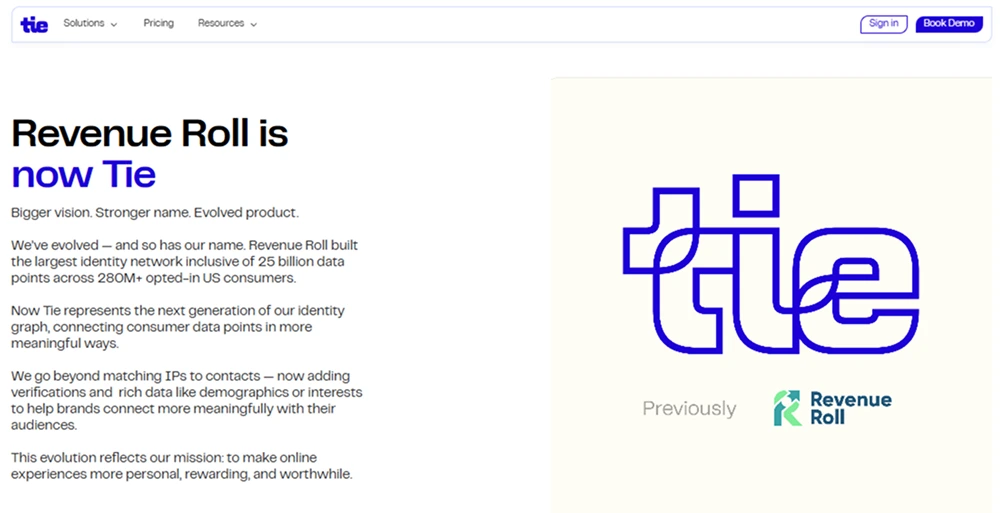Tie (Revenue Roll) Overview & 2025 Industry Position
In a landscape crowded with payout platforms, Tie (Revenue Roll) distinguishes itself with a sharp focus on automation, UX simplicity, and modular revenue tooling for growing brands, creators, and digital platforms. Its 2025 momentum hinges on bridging embedded finance with seamless UX, allowing non-financial companies to deploy branded payouts, automate commissions, and monetize faster with minimal lift.
Positioned between pure fintech infrastructure and creator/digital economy enablement, Tie (Revenue Roll) addresses a central 2025 theme: non-finance businesses embedding financial capabilities natively. Whether for affiliate commissions, campaign disbursements, or multi-vendor settlements, Tie makes it point-and-click simple—without sacrificing flexibility.
From Launch to 2025: Tie (Revenue Roll)’s Journey
Launched quietly in early 2020, Tie began as a creator payment toolkit targeting influencer managers. By mid-2021, it expanded into marketing payouts across affiliate, referral, and brand partners. In 2022, “Revenue Roll” became part of its rebrand—highlighting its unique spin on automating revenue operations, not just payouts.
By 2023, Tie had onboarded several SaaS, marketplaces, and e-commerce enterprises looking to simplify programmable revenue disbursements. Version 3.0 (released late 2024) introduced a modular dashboard and full webhook/API suite, setting the stage for deeper integrations. As of July 2025, Tie’s strategic push centers around no-code workflows, ultra-flexible revenue rule engines, and embedded white-label payout portals.

Tie (Revenue Roll) Key Features
Tie (Revenue Roll)’s environment centers around flexibility and automation. Key innovations for 2025 include:
- Dynamic Payout Rules: Set per-user or per-partner revenue logic with conditional triggers.
- White-label Portals: Launch branded influencer, partner, or vendor payout dashboards instantly.
- Asynchronous Revenue Events: Process events from Stripe, Shopify, HubSpot, or APIs into ready-to-send payouts.
- Global Payout Infrastructure: Covering 100+ countries with built-in tax, compliance, and FX costs.
- Automated Commission Logic: Great for referral programs, affiliate managers, or decentralized teams.
Workflow & UX
Tie’s UX shines with minimalist dashboards, guided payout workflows, and real-time validation of rules and balances. End-users (partners, vendors, influencers) get access to mobile-optimized portals for account sync, tax form uploads, and payout method management.
Admins benefit from intuitive rule editors, webhook support for triggers/events, and fast onboarding via integrations or manual CSV drops. There’s little guesswork—Tie actively flags logic issues or compliance concerns before approval.
Tie (Revenue Roll) Pricing Analysis & Value Metrics
| Plan | Monthly Cost | Included Payouts | Payout Methods | White-labeling |
|---|---|---|---|---|
| Starter | $59 | 100 / mo | Bank, PayPal | No |
| Growth | $199 | 1,000 / mo | Bank, PayPal, ACH | Yes |
| Scale | $499 | 10,000 / mo | All Methods + FX | Yes |
Value Notes: Pricing includes full compliance/tax processing and is significantly lower than traditional affiliate networks or commission processors.
Competitive Landscape
| Platform | Focus | Payout Methods | Best For |
|---|---|---|---|
| Tie (Revenue Roll) | Revenue Ops Automation | Bank, Paypal, FX | Creators, Affiliates, SaaS |
| Tipalti | Enterprise Finance | Global Coverage | Midmarket to Enterprise |
| PartnerStack | Partner Management | Basic | SaaS Startups |
| Payoneer | Freelancer Payouts | Cards | Marketplace Vendors |
Common Use Cases
- Influencer or affiliate payouts from e-commerce stores
- SaaS referral commissions
- Campaign-based payouts in agencies or UGC platforms
- Royalties or shared revenue in digital marketplaces
- Investor or revenue-share distributions for Web3/DAOs
Integrations & Ecosystem Reach
Tie (Revenue Roll) integrates deeply with Stripe, QuickBooks, HubSpot, Zapier, Webhooks, and Make. Shopify app support and payout embed kits make it flexible across commerce, CRM, and general SaaS platforms. When embedded, it merges seamlessly into native workflows.
Pros & Cons of Tie (Revenue Roll)
- Pros: Flexible logic editor, excellent UX, affordable plans, global tax compliance, fast setup
- Cons: Limited analytics for multi-org use, limited offline payout methods, API docs are improving
Pro Tip: Use Rule Templates to jumpstart payout workflows—ideal for affiliate, royalty, and campaign-based teams.
Final Thoughts on Tie (Revenue Roll)
Tie (Revenue Roll) is best suited for lean teams who want to offload the complexity of revenue-based payouts—without hiring finance ops or building in-house tooling. Its standout advantage is modular flexibility. For small SaaS and mid-market brands focused on scaling partnerships, campaigns, or ecosystems, it’s a high-leverage decision.
Tie (Revenue Roll) FAQ
Yes. Tie handles W-9/W-8BEN collection, 1099 generation, KYC, and global compliance.
Yes. Growth and Scale plans include full white-label capabilities for logos, color, and URL control.
Bank transfer, ACH, PayPal, FX transfers, and card disbursements are supported based on user location and plan tier.
Teams managing payouts to affiliates, creators, campaign contributors, or partner programs who want automation and cost-control.
Minimal. Non-tech users can use built-in templates. Developers can leverage APIs for deeper control.